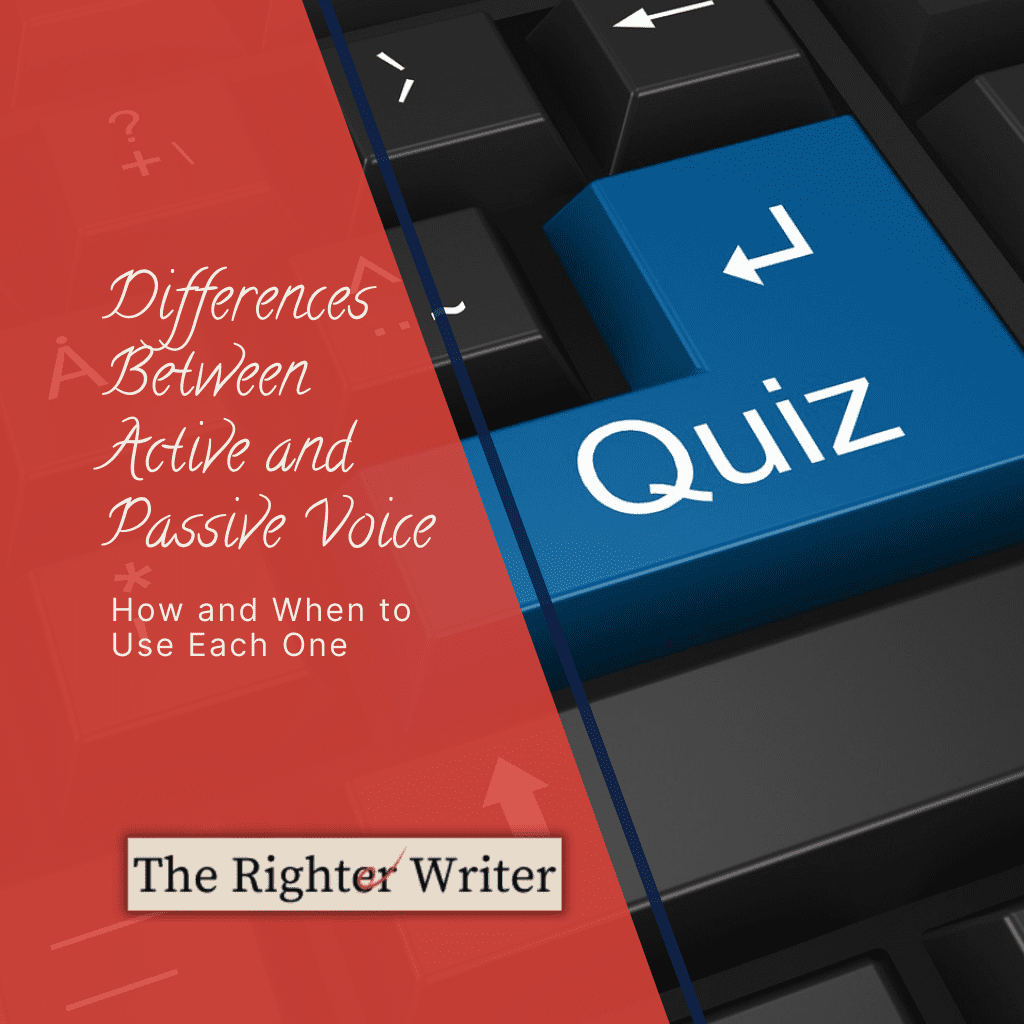
Writing Craft Book Reviews: A Book A Week
Fourth and last (for now!) in our series of book reviews featuring Kindle Unlimited books that explain ways to outline a novel. Let’s get ready for NaNoWriMo!
I'm an affiliate.
Some of the links on this page are affiliate links, but the opinions in my posts are my own, and I only mention products that I like and use myself. As an Amazon Associate, I earn from qualifying purchases. What that means is that if you click one of the links on my site and make a purchase, I might recieve compensation at no extra cost to you.

“Don’t use passive voice!”
“Active voice is strong and passive voice is weak!”
“Passive voice is too confusing; only use active voice!”
Teachers said it in high school, professors repeated it in university, and, now that I’m writing a novel, I see it in a bunch of writing workshops and classes.
A lot of writers don’t know, but it’s an important distinction to understand.
In this blog post, I will:
(There is also a quiz halfway through the post, so you can see if you’re getting the differences down!)
In terms of structure, the fundamental difference between passive and active voice is that in passive sentences, the object receives the action of the verb, while in active voice sentences, the subject performs the action of the verb.
That’s a complicated way of saying the thing that is acting—the do-er—is the subject of a sentence in the active voice.
But the thing that is acted upon—the done-to—is the subject of a sentence in the passive voice.
Wait…that was pretty complicated, too.
In the sentence “The book was published by a small press,” “The book” is the subject, and “was published” is the verb. This sentence is in the passive voice, so the object (“a small press”) receives the action of the verb.
The order of the words goes like this:
The thing that something is done to – the action that is done – the thing that does it
Or in this case:
The book – was published – by a small press.
(Keep an eye on the little words “was” and “by” because they’re important clues.)
If I write in the passive voice, I don’t even need to write that entire sentence.
I could just say, “The book was published,” and it would make sense.
As a reader, I don’t know who did the publishing, but I don’t really wonder about it, either.
If I take the same sentence and write in the active voice, the order changes.
This time, the sentence is “A small press published the book,” “A small press” is the subject, and “published” is the verb. This sentence is in the active voice, so the object is “the book” and comes at the end.
The order of the words goes like this:
The thing that does the action – the action – the thing that the action is done to
Or in this case:
A small press – published – the book.
(Did you notice that the little words “was” and “by” are gone? That’s one difference between active and passive voice.)
Remember how I shortened the sentence when it was in the passive voice? (“The book was published.”) I can’t really do that when I write in the active voice.
If you read the phrase, “A small press published,” your response would probably be, “What? What did it publish?”
In the active voice, we need to include the thing that does the action, or we get confused.

So, we’ve looked at three different clues to tell the difference between passive and active voice when you’re looking at a sentence.
The first clue is the form of the verb. In most cases, verbs in the passive voice are formed with “to be” (am, is, are, was, were) and a past participle (for example, “published” in the example above). Verbs in the active voice are usually regular verbs and don’t use “to be.”
He was kissed by her.
(This is in passive voice, and the verb is “was kissed.”)
She kissed him.
(This one is in active voice, and the verb is “kissed”—without the word “was.”)
Clue number two is the order of the words, or the position of the subject and object in a sentence.
When you write in the passive voice, the object (the thing that the action is done to) appears before the verb.
On the other hand, in sentences using the active voice, the subject (the thing that does the action) appears before the verb.
The door was slammed by her.
(This sentence is in the passive voice, so “the door” comes before the verb “was slammed.”)
She slammed the door.
(This time it’s in the active voice, so “she” comes before the verb “slammed,” and “the door” comes at the end.)
Finally, for clue number three, we look for the thing doing the action.
If you can’t find a subject (a do-er), then you’re most likely looking at a passive sentence.
The window was broken.
(Who broke it? We don’t know, and that’s a big clue that this is a passive sentence.)
Ethan broke the window.
(Ah-ha! Now that we know who—“Ethan”—did the action—“broke”—to what—“the window”—we can write the sentence in the active voice.)
So, to review, you can tell the difference between passive and active voice by:
Now that you know some differences between active and passive voice, let’s look at how to revise a sentence.
If you want to change a sentence from the passive voice to the active voice, you need to find the subject and make it do the action.
The window was broken by Ethan. (passive)
Ethan broke the window. (active)
If you want to change a sentence from the active voice to the passive voice, you need to put the object before the verb and use a “to be” verb.
She slammed the door. (active)
The door was slammed by her. (passive)

There are a few things to keep in mind when you write in the passive voice.
If you use the passive voice a lot in day-day-to-day writing, it can sound weak, pretentious, or weasely.
The media uses passive voice a lot because it makes the action more important than the person who did it.
That is not always a good thing, though; passive voice takes away the sense of responsibility in the story.
Here is an excerpt from an article in the Philadelphia Inquirer that explains why it is important to think about active vs passive voice and make a conscious decision which to use:
A month after George Floyd was killed, protesters — who sometimes clash violently with police — continue to fill the streets of Philadelphia and cities around the world.
Ugh, no. Let’s try that sentence again.
A month after police killed George Floyd, the streets of Philadelphia and cities around the world continue to be filled with sometimes violent clashes between police and protesters.
Maybe you learned growing up that you should avoid writing in the passive voice. But no one told you that doing so can be a matter of life and death. These two sentences are textbook examples of why: because passive voice eschews responsibility for action. The sentences are factually equal, but their active/passive-voice dance affects how you feel about what occurred.
Published June 24, 2020
You do want to write in the passive voice when you don’t know who did the action or if who did it is not important.
A good example of this is scientific writing, which used to be written almost entirely in passive voice.
It’s becoming more popular among some journals to write in the active voice, but others still prefer the traditional style.
Here on the guidelines page, APA style guide says:
Putting verbs in passive voice can also make the writing sound more formal, so some businesses encourage it for reports.

Let’s look at some more differences between active and passive voice examples. These paragraphs are written in the wrong tenses and need to be changed.
Normally, a thriller novel is something you would definitely write in the active voice, so it will sound urgent and visceral.
If you write in the passive voice, on the other hand, you get this:
The bullets were shot at us from across the room. There was a pause as the attackers’ guns were reloaded. I moved so I was hidden by the column and made sure that my Glock was reloaded, too.
We had to get down the road that was blocked by these treasure hunters. The statue needed to be returned to the temple or we would all be crushed when the demon was brought to life.
Not the thrilling-est thriller.
Now let’s rewrite it with more active verbs.
The bullets flew at us from across the room. There was a pause as the attackers reloaded, so I hid behind the column and reloaded my Glock, too. We needed to get past these treasure hunters blocking the road. The statue needed to be returned to the temple, or when the cultists brought the demon to life, he would crush us all!
Eh, it’s still not perfect, but there is more tension and it feels more immediate.
I left one phrase in the passive voice—“The statue needed to be returned to the temple.”—because the most important part of that idea is the statue.
The subject doesn’t matter as much as the statue because, no matter who returns it, as long as the statue is returned, everything will be fine.
Next, here’s an example of a paragraph from a lab report.
These are normally written in the passive voice, but this is what it sounds like in the active voice:
First, we added 50 ml of Reagent A and 10 ml of Reagent B to the test tube. Then, we put the tube seven cm over a flame that was burning blue. We agitated it as the fire heated it for two minutes, and then a fridge cooled the tube for 20 minutes.
When we measured that the mixture was 50 degrees Fahrenheit, we filtered it and measured the precipitate. There was 0.05 ounce of the precipitate.
It’s okay, but it sounds a bit like a report that a junior high student might write.
Let’s rewrite in the passive voice, and see how that sounds:
Fifty ml of Reagent A and 10 ml of Reagent B were added to a test tube, which was placed seven cm over a blue flame. It was agitated as it heated for two minutes, and then it was cooled for 20 minutes.
When the mixture measured 50 degrees Fahrenheit, it was filtered, and the precipitate was measured. There was 0.05 ounce of the precipitate.
While some people (and some scientific journals) may prefer the active voice, I prefer the formal, polished style of passive voice scientific writing.
So, now you can:
But how do you tell which is best for you writing, specifically?
Active voice is better for most types of writing because it makes your sentences shorter, easier to read, and more direct.
It can also make the writing sound more urgent or exciting.
Use active voice unless you have a reason not to (like the example in the lab report paragraph above).
This includes fiction and nonfiction prose.
Use passive voice when you want your writing to sound calm or neutral, or when the subject of the sentence is more important than the actor.
This includes scientific writing, technical writing, and some forms of business writing.
However, passive voice can make your sentences longer and more confusing, so use it sparingly.
If you’re still not sure which voice to use, read your work aloud and see which works.
Better yet, get someone else to read it and point out places where it sounds convoluted or stogy (passive voice that should be active) and places that sound abrupt or rude (active voice that should be passive).
So there you have it—a guide to understanding active and passive voice, how to switch between them, and when to use each.
Armed with this information, you can make your writing more powerful and effective.
Remember, the best way to improve your writing is through practice—so keep at it!
And feel free to reach out if you want a second set of eyes to look at your voice; my contact page is here.
I created some Google Slides with worksheets on the differences between active and passive voice.
They are available for free on my Teachers Pay Teachers store. (As of May, 2022, they are the only thing in my store…)
The link to the store is here: The Righter Writer on TpT
If you don’t have a TpT account, you can also just download the Google Slide files straight from this link: The Differences Between Active and Passive Voice Worksheets

I help authors, researchers, business people, students, and web marketers to polish their writing before they send it out into the world.

Fourth and last (for now!) in our series of book reviews featuring Kindle Unlimited books that explain ways to outline a novel. Let’s get ready for NaNoWriMo!

Third in our series of book reviews featuring Kindle Unlimited books that explain ways to outline a novel. Let’s get ready for NaNoWriMo!

Second in our series of book reviews featuring Kindle Unlimited books that explain ways to outline a novel. Let’s get ready for NaNoWriMo!

8 Responses
hello
i am also a writer. i write short stories for children. love your article. the examples gave me some ideas. you can read my stories in my website.
I’m glad you got some good ideas; I’ll definitely check out your stories! <3
Wow, great breakdown. So much easier to understand this way.
Thanks! I’m glad it was easy to follow. ☺️
Some of the text it was hard to read. However I did like the bold text and it did help me understand active and passive text.
Thanks for the feedback! Was the writing hard to follow, or was it the font or layout? I’d love to know what I could do better! 🙂
Thank you. Thank you! I get this often when I write a blog. My SEO program often flags my post for too many passive sentences. Now I know how to correct them. Even though I looked for an explanation I still did not quite understand. Bookmarked this post for future reference.
You’re right, the autocorrect programs can flag passive sentences, but it’s sometimes hard to know how to fix them. I’m glad you found this post useful!